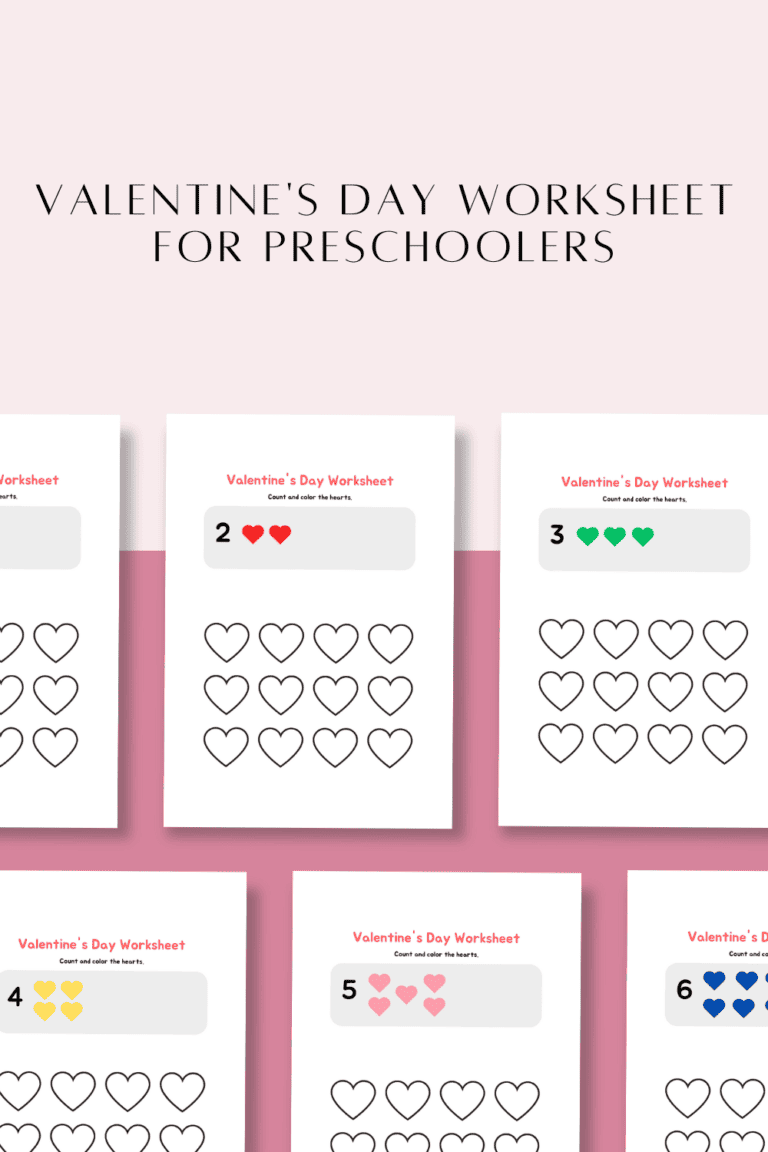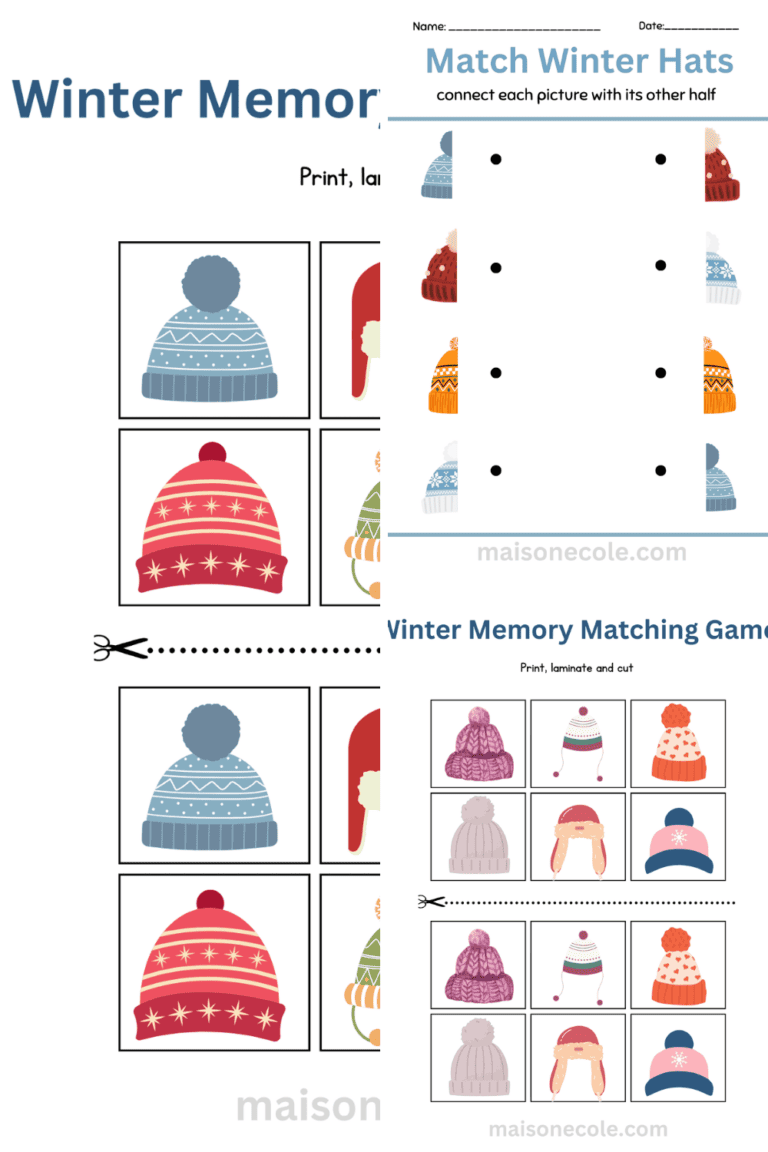40 Fun Hands-On Gardening Activities for Kids
This post may contain affiliate links, meaning I make a commission if you purchase through my links, at no extra cost to you. Disclosure here
This blog post is all about the best hands-on gardening activities for kids all ages.
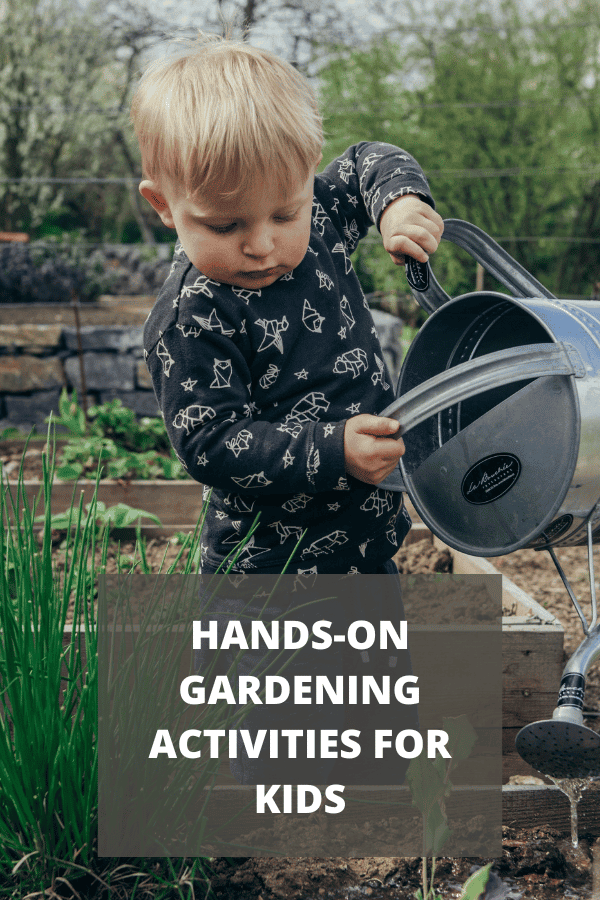
As a mom of two, I’ve seen how much children can learn and grow through gardening. My 3-year-old began by helping water our plants and soon took an interest in everything from our vegetable garden to the insects we find among the leaves.
In this blog post, I’m sharing 40 hands-on gardening activities that my kids have loved. Suitable for all ages, these activities are great for getting your little ones involved and excited about gardening.
From my family to yours, explore these fun, safe, and educational activities that are sure to nurture a love of nature in your children too.
This blog post is all about the best hands-on gardening activities for kids.
Hands-On Gardening Activities
Garden Fun for Kids
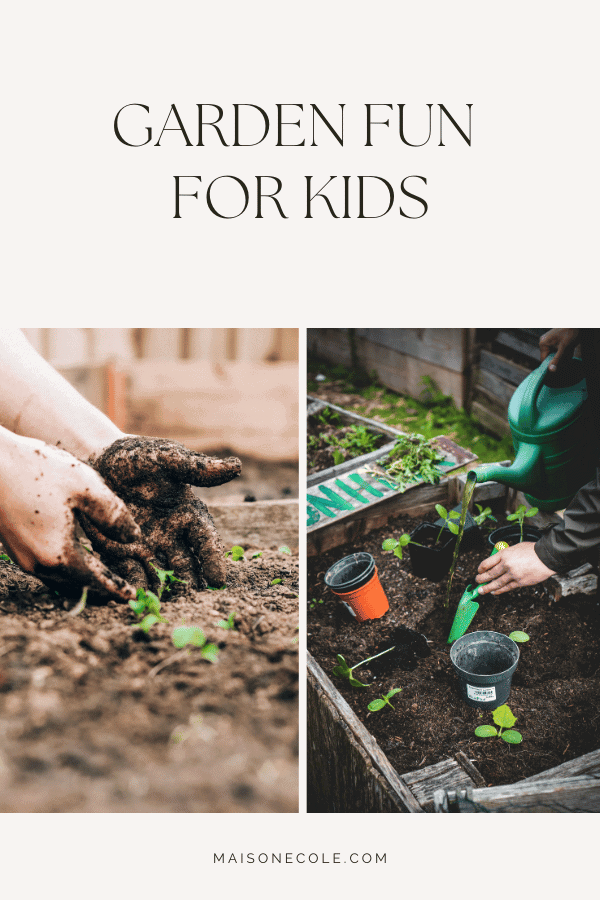
1. Seed Jar Science
In this engaging activity, children will closely observe the process of seed germination. By placing seeds in a clear jar against a moist paper towel, they’ll watch as seeds sprout and roots develop. This process not only introduces them to the basics of plant growth but also sharpens their observation skills and fosters patience.
Materials Needed: Clear jars, paper towels, and seeds (like beans or peas).
Instructions: Place the wet paper towel inside the jar, then position the seeds between the jar and the towel. Observe the seeds daily for changes.
Safety Tips: Choose non-toxic seeds and ensure adult supervision to manage the water and prevent any spills.
2. Miniature Garden Creation
In this activity, children will design and create their own miniature gardens in small containers. This project encourages creativity in arranging plants, stones, and miniature decorations. It’s a fantastic way for kids to learn about spatial awareness and plant care, including watering and sunlight needs.
Materials Needed: Small containers, soil, small plants or seeds, decorative stones, and miniature garden accessories.
Instructions: Fill the container with soil, plant the seeds or small plants, and decorate with stones and accessories.
Safety Tips: Ensure all materials are safe and non-toxic, and provide guidance on handling plants and small objects.
3. Vegetable Garden Planting
In this activity, children get to plant and nurture their own vegetable garden, learning about the plant growth cycle. It’s a hands-on way for them to understand the process from seeding to harvesting. This activity also encourages healthy eating habits, as kids are often more inclined to try vegetables they have grown themselves. It’s a great opportunity for them to learn about responsibility and the rewards of patience and care.
Materials Needed: Easy-to-grow vegetable seeds like tomatoes, radishes, carrots, and lettuce; garden tools; soil; and a suitable planting area or containers.
Instructions: Prepare the soil, plant the seeds or young plants, and care for them with regular watering and weeding.
Safety Tips: Supervise the use of garden tools and ensure safe handling and consumption of the vegetables.
This approach not only educates them about plant biology but also promotes a healthier lifestyle by connecting them directly to the food they eat.
4. Flower Pressing Art
This activity combines the beauty of gardening with the creativity of art. Children will collect flowers and leaves from the garden and learn how to press them for artistic projects. This activity not only teaches them about different plant species but also nurtures an appreciation for nature’s aesthetics. It’s a wonderful way to preserve the beauty of the garden and enhance their artistic skills.
Materials Needed: Fresh flowers or leaves, heavy books, absorbent paper, and optional art materials for creating a display. Optional Pressed Flower Art Kit if you prefer a ready to use tool.
Instructions: Place flowers or leaves between absorbent paper and press under heavy books. Leave for a few weeks to dry completely.
Safety Tips: Ensure the plants chosen are non-toxic and supervise the handling of heavy books.
5. Insect Exploration in the Garden
This activity turns the garden into a fascinating laboratory for children to explore and learn about different insects. It encourages their interest in entomology and ecology, as they discover the various roles insects play in the garden ecosystem. Kids can learn about beneficial insects and the importance of biodiversity.
Materials Needed: Magnifying glass, a notebook for observations, and a guide to common garden insects.
Instructions: Gently observe and identify insects in the garden, noting their characteristics and behaviors.
Safety Tips: Teach children to observe without touching or disturbing the insects, and ensure they understand the importance of not harming the garden’s tiny inhabitants.
6. Garden Treasure Hunt
Transform the garden into a thrilling adventure with a treasure hunt. This activity stimulates children’s problem-solving skills and observation abilities as they search for natural or hidden items based on clues. It’s a fun way to explore and learn about different plants, garden features, and even wildlife in their natural habitat.
Materials Needed: Prepared clues related to garden elements, hidden treasures or items to find, and a map of the garden (optional).
Instructions: Provide clues leading to different parts of the garden and hidden items.
Safety Tips: Ensure the garden is safe for exploration and that all hidden items are non-hazardous.
7. Bird Feeder Crafting
This activity involves creating simple bird feeders, which helps children learn about local bird species and the importance of wildlife care. It’s a great way to encourage an interest in ornithology and environmental stewardship. Children will delight in watching birds visit their handmade feeders.
Materials Needed: Common household items like milk cartons, string, birdseed, and peanut butter.
Instructions: Decorate and assemble the feeders, then fill them with birdseed.
Safety Tips: Ensure all materials are safe and non-toxic, and supervise the project to help with cutting or assembling parts.
8. Plant Science Experiments
In these experiments, kids can explore how plants grow under different conditions, introducing them to basic scientific principles and hypothesis testing. This is a hands-on way to introduce basic scientific concepts and encourage analytical thinking. They can observe how variables like light, water, and soil type affect plant growth.
Materials Needed: Various seeds, pots, soil, water, and controlled light sources.
Instructions: Set up experiments with different conditions for each plant. For instance, grow plants with varying amounts of light or water.
Suggested Questions for Discussion:
- “Can plants grow without light?”
- “What happens if we water this plant a lot versus a little?”
- “Do plants grow better in soil or sand?”
Encourage kids to make hypotheses about what will happen and then observe the outcomes.
Safety Tips: Ensure safe handling of all materials and emphasize the need for consistent observations for meaningful results.
9. Decorate Garden Stones
This creative activity involves decorating garden stones, which can add a personalized touch to any garden space. It’s a great way for children to express their creativity and to make a lasting contribution to the family garden. They can paint stones in bright colors or with fun designs.
Materials Needed: Stones of various sizes, outdoor paint, brushes, and protective clothing for painting.
Instructions: Clean the stones, paint designs or messages, and then place them around the garden.
Suggested Discussion Points:
- Encourage children to think about where their decorated stones will go and why.
- Ask them how their stone design represents something important or special to them.
Safety Tips: Ensure paints are non-toxic and supervise the activity to avoid messes and ensure proper drying of the stones.
10. Herb Garden Care
In this activity, kids can cultivate their own herb garden, learning about different herb varieties and their uses. This introduces them to basic gardening skills and the concept of using plants for culinary purposes. They can grow herbs like basil, mint, or parsley.
Materials Needed: Herb seeds or seedlings, pots or a small garden patch, soil, and water.
Instructions: Plant and care for the herbs, teaching kids to water them regularly and harvest them for cooking.
Discussion Points:
- Ask kids about the differences in scent and taste of various herbs.
- Encourage them to think of recipes or dishes where these herbs could be used.
Safety Tips: Supervise planting and harvesting, ensuring that only edible herbs are grown and used.
Urban and Rooftop Gardening Activities
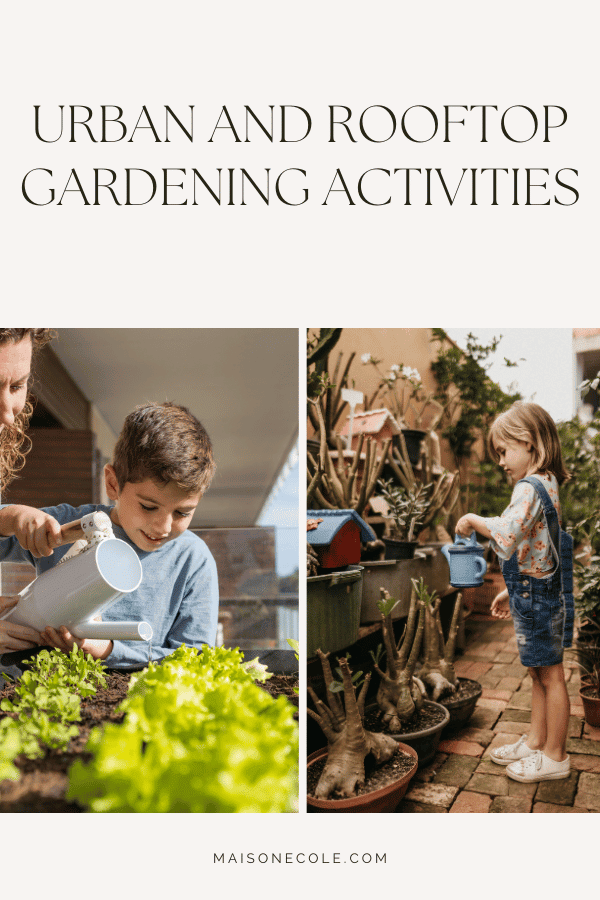
11. Container Vegetable Gardening
This activity is perfect for urban settings where space is limited. Kids can learn to grow vegetables in containers, understanding the challenges and rewards of urban gardening. They can grow vegetables like cherry tomatoes, lettuce, or carrots.
Materials Needed: Containers, potting soil, vegetable seeds or seedlings, water, and a sunny spot.
Instructions: Plant the seeds or seedlings in containers, ensure they get enough sunlight, and water them regularly.
Discussion Points:
- Discuss how growing vegetables in containers differs from traditional gardening.
- Encourage kids to observe the growth process and note any changes.
Safety Tips: Choose appropriate-sized containers and ensure a safe setup for the gardening space, especially on balconies or rooftops.
12. Herb Wall Art
This activity lets children create a vertical herb garden, which is an excellent way for them to learn about space-efficient gardening in an urban setting. They can grow herbs like thyme, basil, or mint in wall-mounted planters.
Materials Needed: Wall planters or hanging containers, herb seeds or seedlings, potting soil, and water.
Instructions: Set up the wall planters, plant the herbs, and maintain them with regular watering and care.
Discussion Points:
- Discuss the benefits of vertical gardening in urban areas.
- Encourage kids to smell and taste the herbs, discussing their different uses.
Safety Tips: Ensure the wall planters are securely mounted and placed at a safe height for children to access.
13. Rooftop Rainwater Collection
This activity introduces children to sustainable practices by setting up a system to collect and use rainwater for the garden. It’s particularly suitable for rooftop or balcony gardens in urban areas. They’ll learn about water conservation and its importance in gardening.
Materials Needed: Containers or barrels for collecting rainwater, a funnel or gutter system for directing water, and possibly a filter.
Instructions: Set up the containers to catch rainwater from downspouts or direct rainfall, and use the collected water for plants.
Discussion Points:
- Discuss the importance of water conservation and how rainwater collection helps the environment.
- Encourage kids to monitor the amount of water collected and plan its usage.
Safety Tips: Ensure the setup is stable and secure, and that children are supervised, especially on rooftops or high balconies.
14. Recycled Planters
This activity encourages creativity and environmental awareness by having children use recycled materials to make unique planters. It’s a fun way to teach about recycling and repurposing in urban gardening.
Materials Needed: Recycled items like old boots, cans, or plastic bottles, soil, and small plants or seeds.
Instructions: Prepare the recycled items for planting, fill them with soil, and plant seeds or small plants.
Discussion Points:
- Discuss how recycling can be integrated into gardening and the importance of reusing materials.
- Let children be creative in choosing and decorating their planters.
Safety Tips: Ensure the recycled materials are clean, safe, and have no sharp edges.
15. Pollinator Garden
In this activity, kids can create a garden space that attracts and supports pollinators like bees and butterflies. They’ll learn about the importance of pollinators in ecosystems and how certain plants can attract them.
Materials Needed: Flower seeds or plants known to attract pollinators (like lavender, sunflowers, or butterfly bushes), soil, and a gardening space.
Instructions: Plant the flowers in a designated area or containers, and maintain them to attract pollinators.
Discussion Points:
- Discuss the role of pollinators in nature and why they are important for gardens.
- Observe and identify different pollinators that visit the garden.
Safety Tips: Teach children to observe the insects from a safe distance and not to disturb them.
16. Balcony Composting
This activity teaches kids about sustainable waste management through composting, suitable for small spaces like balconies. They’ll learn how kitchen and garden waste can be converted into nutrient-rich soil.
Materials Needed: A small compost bin or container, compostable waste (like fruit peels, vegetable scraps, and leaves).
Instructions: Set up the compost bin, add the organic waste, and regularly mix and maintain it.
Discussion Points:
- Discuss the composting process and how it benefits the environment.
- Observe the transformation of waste into compost over time.
Safety Tips: Ensure the compost bin is securely placed and maintained, and guide children on what can and cannot be composted.
17. Sun Mapping
In this engaging activity, children will learn about the importance of sunlight in gardening by mapping sun exposure in different areas of a balcony or rooftop garden. This helps them understand which plants are best suited for various parts of their urban garden space.
Materials Needed: Graph paper or a chart, a compass, and a clock or timer.
Instructions: Track and record the amount of sunlight different areas receive throughout the day.
Discussion Points:
- Discuss how different plants require varying amounts of sunlight.
- Encourage kids to decide the best locations for different types of plants based on their sun mapping results.
Safety Tips: Ensure children are supervised on balconies or rooftops and are protected from prolonged sun exposure during the activity.
18. Grow an Aromatic Garden
This activity involves creating an aromatic garden with herbs and flowers. Children will learn about different plant scents and their uses, including how they can be used in cooking and even in making perfumes.
Materials Needed: Pots, soil, and seeds or seedlings of aromatic plants like lavender, mint, and rosemary.
Instructions: Plant and care for the herbs and flowers in the chosen space.
Discussion Points:
- Explore the scents of different plants and discuss their various uses, including culinary and perfume-making.
Safety Tips: Ensure all plants are safe and non-toxic, and supervise children during the gardening process.
19. Urban Garden Scavenger Hunt
Turn the urban garden into a playground with a scavenger hunt. This fun activity encourages children to explore and learn about their garden environment. They’ll engage in a playful search for various plants, insects, and garden features.
Materials Needed: A list of items to find in the garden, which could include specific types of plants, insects, or garden tools.
Instructions: Give children the list and let them search for the items in the garden.
Discussion Points:
- Talk about each found item, its role in the garden, and interesting facts about it.
Safety Tips: Ensure the garden is safe for exploration and all items on the list are appropriate for children to handle.
20. Miniature Roof Garden Model
This activity involves kids creating a small-scale model of a rooftop garden, which helps them understand the principles of rooftop gardening and green building. They can use various materials to replicate garden beds, green roofs, and other elements.
Materials Needed: Cardboard or wooden base, small plants or moss, soil, and other craft materials for decoration.
Instructions: Design and construct a miniature rooftop garden on the base, using creativity and understanding of gardening principles.
Discussion Points:
- Discuss the benefits of rooftop gardens in urban environments and how they contribute to green living.
Safety Tips: Ensure all materials are safe for use by children and provide guidance as they build their models.
Preschooler-Focused Activities

21. Planting in Egg Cartons
This activity is perfect for preschoolers, teaching them about the basics of planting using egg cartons as mini planters. It’s a simple and effective way to start small plants indoors.
Materials Needed: Empty egg cartons, soil, seeds (like beans or small flowers).
Instructions: Fill each egg compartment with soil, plant the seeds, and water them. Place in a sunny spot.
Discussion Points:
- Talk about how plants grow from seeds and the care they need in their early stages.
Safety Tips: Ensure that the preschoolers handle the soil and seeds under supervision and that the plants are non-toxic.
22. Garden Sensory Bin
This activity is great for preschoolers to explore different textures and elements of a garden in a controlled environment. They can dig, plant, and play in a sensory bin filled with soil, small plants, and garden tools.
Materials Needed: A large bin, soil, small garden tools, and various safe garden elements like small plants, rocks, and fake insects.
Instructions: Fill the bin with the materials and let the children explore and play.
Discussion Points:
- Encourage them to describe what they feel, see, and smell while playing in the sensory bin.
Safety Tips: Ensure all materials are safe for young children and supervise them to prevent ingestion of non-edible elements.
23. Painting with Vegetables
A fun and creative activity for preschoolers, this involves using vegetables as stamps to create art. It’s an excellent way for them to explore patterns, colors, and the shapes of various vegetables.
Materials Needed: Vegetables cut into different shapes (like potatoes, bell peppers, or carrots), paint, and paper.
Instructions: Dip the vegetable cuts in paint and stamp them onto paper to create various designs.
Discussion Points:
- Talk about the different shapes and textures of vegetables and how they create unique patterns.
Safety Tips: Ensure the paint is non-toxic and supervise the activity to prevent ingestion of paint or vegetables.
24. Mud Kitchen Play
This activity allows preschoolers to engage in imaginative play by creating a mud kitchen in the garden. It’s a hands-on experience where they can mix soil, water, and garden elements to make mud pies and other creations.
Materials Needed: A designated outdoor area, old kitchen utensils, containers, soil, and water.
Instructions: Set up the mud kitchen area and let the children use their imagination to cook and play.
Discussion Points:
- Encourage discussions about different soil textures and the fun of playing with natural materials.
Safety Tips: Ensure the play area is safe and the children are dressed in appropriate clothing for messy play. Supervise to ensure they don’t consume soil or plants.
25. Bug Hunt with Magnifying Glasses
In this activity, preschoolers explore the garden with magnifying glasses to find and observe insects. It’s an engaging way to introduce them to insect diversity and their environment.
Materials Needed: Magnifying glasses.
Instructions: Guide the children through the garden, encouraging them to look closely at different insects.
Discussion Points:
- Ask the children to describe the insects and discuss similarities and differences, helping them categorize what they see.
Safety Tips: Instruct children to observe insects without touching, and ensure they are careful not to disturb the garden.
26. Fairy and Dinosaur Gardens
This creative activity involves preschoolers making themed miniature gardens with elements like fairies or dinosaurs. It allows them to use their imagination in a gardening context.
Materials Needed: Small containers, soil, small plants, and fairy or dinosaur figurines.
Instructions: Help the kids arrange the plants and figures in the containers to create their themed gardens.
Discussion Points:
- Encourage the children to tell stories about their gardens and the characters in them.
Safety Tips: Ensure the figures and plants are safe for small children and supervise the assembly of the gardens.
27. Water Play with Plants
This activity is designed for preschoolers to learn about watering plants. It combines the fun of playing with water with the responsibility of caring for plants.
Materials Needed: Small watering cans, plants in pots, and a water source.
Instructions: Teach the children how to gently water the plants, explaining why plants need water.
Discussion Points:
- Talk about the importance of water for plant growth and encourage the children to notice the changes in plants after watering.
Safety Tips: Supervise the activity to ensure safe use of water and that the plants are not over-watered.
28. Nature Walks and Leaf Collecting
This activity involves taking preschoolers on nature walks to collect different types of leaves. It’s a great way for them to learn about various trees and plants.
Materials Needed: Bags or containers for collecting leaves, and a nature trail or garden area.
Instructions: Guide the children on a walk, encouraging them to collect different leaves.
Discussion Points:
- Discuss the differences in leaf shapes, sizes, and textures. Talk about the types of trees and plants the leaves come from.
Safety Tips: Ensure the walk is on safe, child-friendly paths and supervise the collection to ensure only safe plants are touched.
29. Story Time in the Garden
Engage preschoolers in story time sessions in the garden, where they can connect with nature while listening to garden-themed stories or books. It’s a relaxing and educational way to enjoy the outdoors.
Materials Needed: Children’s books with nature or garden themes, comfortable seating like blankets or small chairs.
Instructions: Choose a calm, pleasant spot in the garden and read stories to the children.
Discussion Points:
- Encourage discussions about the stories, relating them to the surrounding garden environment.
30. Simple Garden Chores
Introduce preschoolers to gardening through simple chores. This teaches them about responsibility and the basics of plant care.
Materials Needed: Child-sized gardening tools like a small rake, shovel, and watering can.
Instructions: Assign age-appropriate tasks such as watering plants, pulling weeds, or raking leaves.
Discussion Points:
- Talk about how each task helps the garden and the importance of regular care.
Safety Tips: Ensure tools are safe and appropriate for their age, and supervise all activities to prevent accidents.
Eco-Gardening STEM Projects

31. Hydroponic Mason Jar Garden
This activity introduces children to the concept of hydroponic gardening, where they grow plants in water without soil. Using mason jars, they can see how roots develop in a clear medium.
Materials Needed: Mason jars, water, hydroponic nutrients, and small plants or seeds suitable for hydroponic growth.
Instructions: Set up the jars with water and nutrients, then place the plants or seeds in them.
Discussion Points:
- Talk about how plants can grow without soil and the role of nutrients in plant growth.
Safety Tips: Ensure the jars are placed in a stable position to prevent tipping and that the water is changed as needed.
32. Rooftop Rainwater Harvesting Experiment
This STEM activity helps children understand how to collect and use rainwater, particularly useful in rooftop gardening. It demonstrates water conservation and sustainable gardening practices.
Materials Needed: Containers or barrels, a funnel system, and a measuring tool like a ruler or jug.
Instructions: Set up a system to collect rainwater from rainfall or a downspout, then measure and record the amount of water collected.
Discussion Points:
- Discuss the importance of water conservation and how collected rainwater can be used in gardening.
Safety Tips: Ensure the setup is secure and stable, especially in high places like rooftops.
33. Build a Mini Green Roof
In this activity, children create a small-scale model of a green roof, which is an environmentally friendly roofing option that supports plant life.
Materials Needed: A shallow tray or box, soil, small plants or grass seeds, and waterproof lining.
Instructions: Line the tray or box with waterproof material, fill it with soil, and plant seeds or small plants.
Discussion Points:
- Discuss how green roofs help with insulation and biodiversity in urban environments.
Safety Tips: Make sure the materials used are safe and the construction is done under adult supervision.
34. Solar Panel Experiment
This STEM activity helps children understand how solar energy works. It’s especially relevant for green buildings, which often use solar panels for sustainable energy.
Materials Needed: A small solar panel kit or a DIY solar panel setup, a light bulb or small fan.
Instructions: Connect the solar panel to the light bulb or fan and observe how solar energy powers them.
Discussion Points:
- Talk about renewable energy and how solar panels convert sunlight into electricity.
Safety Tips: Ensure all electrical components are handled safely and the experiment is conducted in a well-lit area for maximum solar exposure.
35. Hydroponics vs. Soil Growing
In this activity, children can compare the growth of plants in hydroponic systems versus traditional soil. It’s a great way to understand different growing methods.
Materials Needed: Two sets of plants or seeds, one set for hydroponic growth and one for soil, hydroponic setup, pots with soil.
Instructions: Grow one set of plants hydroponically and the other in soil, then observe and compare their growth.
Discussion Points:
- Discuss the differences in plant growth between the two methods and the advantages of each.
Safety Tips: Ensure that the hydroponic setup is stable and that children understand the care needed for both types of plant growth.
36. Wind Energy on Rooftops
This activity introduces children to the concept of wind energy, particularly relevant for green buildings and urban environments. They can build a simple wind turbine model to understand how wind can be harnessed to generate power.
Materials Needed: DIY wind turbine kit or materials to build a simple turbine (like a small motor, rotor blades, and a mount).
Instructions: Construct the wind turbine and place it in a windy spot to observe how it works.
Discussion Points:
- Talk about renewable energy sources and how wind turbines contribute to sustainable energy solutions.
Safety Tips: Ensure the turbine is built and handled safely, and that its placement does not pose a risk.
37. Green Building Materials Exploration
This educational activity lets children learn about different sustainable building materials used in green buildings. They can explore and compare materials like bamboo, recycled glass, or reclaimed wood.
Materials Needed: Samples of various sustainable building materials.
Instructions: Show the children the different materials, explaining their properties and uses in green construction.
Discussion Points:
- Discuss the environmental benefits of using sustainable materials in building projects.
Safety Tips: Ensure that the material samples are safe to handle and free from sharp edges or harmful substances.
38. DIY Vertical Garden
This activity helps children understand space-efficient gardening, particularly useful in urban areas. They can build a vertical garden, learning about different plants that thrive in limited space.
Materials Needed: Vertical garden frame or hanging containers, soil, and suitable plants (like herbs or small flowers).
Instructions: Set up the vertical garden structure and plant various types of plants in the containers.
Discussion Points:
- Talk about the benefits of vertical gardening in urban spaces where ground space is limited.
Safety Tips: Ensure the structure is securely mounted and the plants are safe for handling by children.
39. Temperature Regulation Experiment
This activity allows children to explore how plants and green roofs can affect the temperature of a building. They can conduct a simple experiment to understand the insulating effect of green spaces.
Materials Needed: Two small model houses or boxes (one with a green roof setup), thermometers, and basic gardening supplies for the green roof.
Instructions: Set up a green roof on one model and measure the temperature inside both models under the same external conditions.
To conduct the Temperature Regulation Experiment effectively:
- Prepare the Models: Use two small model houses or boxes. Equip one with a green roof using soil and small plants or grass.
- Set Up Thermometers: Place a thermometer inside each model to measure the internal temperature.
- Conduct the Experiment: Place both models outside in the same environmental conditions. Record the temperature in each model at regular intervals over a period (e.g., every hour for a day).
- Compare Results: After the experiment, compare the temperatures recorded in both models to see if the green roof had any effect on temperature regulation.
- Discuss Observations: Encourage children to think about why there might be a temperature difference and what this implies about the role of plants in regulating heat.
This experiment helps children understand the insulating properties of green roofs in a practical, hands-on way.
Discussion Points:
- Discuss how green roofs can help regulate building temperatures and contribute to energy efficiency.
Safety Tips: Ensure the experiment is set up in a safe area and that the children understand the importance of accurate temperature readings.
40. Water Filtration System
In this educational activity, children will build a basic model of a water filtration system, similar to those used in green buildings. This experiment helps them understand sustainable water management.
Materials Needed: Clear plastic bottles cut in half, gravel, sand, activated charcoal, cotton balls, and dirty water (for testing).
Instructions:
- Prepare the Filter: In the cut bottle top, layer the cotton balls, charcoal, sand, and gravel.
- Test the Filter: Pour dirty water through the setup and collect the filtered water in the bottom half of the bottle.
Discussion Points:
- Discuss the importance of clean water and how filtration systems can help conserve and reuse water in urban settings.
Safety Tips: Supervise the experiment closely, especially while handling charcoal and pouring water. Make sure children understand not to drink the filtered water, as it’s not safe for consumption.
YOU MAY ALSO LIKE
CREATING THE ULTIMATE KIDS SNACK STATION: 10 MUST-HAVE ELEMENTS AND DESIGN TIPS
10 QUICK TIPS FOR ORGANIZING YOUR CHILD LEARNING SPACE
PRE-READING SKILLS: EMPOWER YOUR CHILD’S FIRST STEPS IN READING
Best Hands-On Gardening Activities
That concludes the list of hands-on gardening activities for kids, covering a wide range of topics from basic gardening skills to more advanced concepts like hydroponics and green building. Each activity is designed to be educational, engaging, and fun, providing children with hands-on experiences that teach them about the natural world and sustainable practices. Whether in a small urban space or a larger garden, these activities offer valuable learning opportunities for children of all ages.
This blog post is all about the best hands-on gardening activities for kids.
Enjoyed these gardening activities for kids? Don’t forget to SAVE THIS PIN for quick access to these fun and educational ideas!


